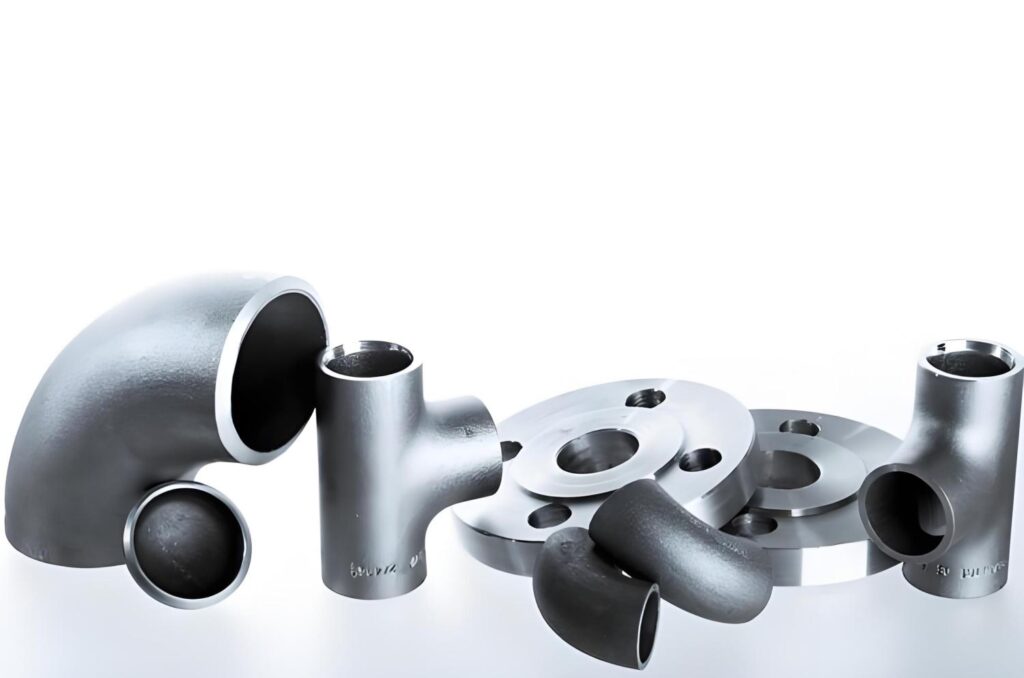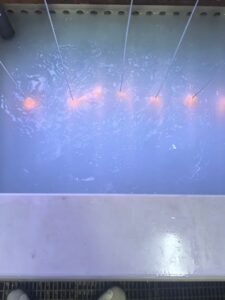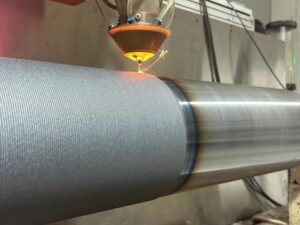What is 2205 Stainless Steel?
2205 stainless steel is a duplex alloy, which means it consists of two different metallurgical phases: austenite and ferrite. This dual-phase microstructure offers a unique combination of strength, corrosion resistance, and durability, making it ideal for demanding environments.
Duplex stainless steels like 2205 were developed to combat common industrial problems such as stress corrosion cracking and pitting. The 2205 grade, in particular, stands out for its high yield strength, approximately double that of standard austenitic stainless steels. This increased strength allows for thinner sections and reduced material costs in projects.
Composition of 2205 Duplex Stainless Steel
The performance of 2205 stainless steel is rooted in its precise chemical composition. The alloying elements are carefully balanced to achieve its duplex microstructure.
Typical composition (by weight):
- Chromium (Cr): 21.0 – 23.0%
- Nickel (Ni): 4.5 – 6.5%
- Molybdenum (Mo): 2.5 – 3.5%
- Manganese (Mn): Up to 2.0%
- Silicon (Si): Up to 1.0%
- Nitrogen (N): 0.14 – 0.20%
- Carbon (C): Maximum 0.03%
- Iron (Fe): Balance
This blend of elements contributes to enhanced strength, resistance to chloride stress corrosion cracking, and improved pitting resistance. Especially in aggressive media like seawater or acidic environments.
Properties of 2205 Stainless Steel
2205 duplex stainless steel is prized for its well-balanced physical and mechanical properties. It bridges the gap between ferritic and austenitic stainless steels, combining their strengths and minimizing their weaknesses.
Mechanical Properties
One of the standout attributes of 2205 stainless steel is its high mechanical strength.
- Tensile Strength: 620 MPa (minimum)
- Yield Strength (0.2% offset): 450 MPa (minimum)
- Elongation: 25% (minimum)
- Hardness: 293 HB maximum (Brinell)
These properties mean that 2205 can often replace thicker sections of lower strength alloys, offering savings in weight and cost without sacrificing performance.
Physical Properties
The physical characteristics of 2205 stainless steel further support its utility in diverse applications:
- Density: 7.8 g/cm³
- Melting Point: 1350 – 1400 °C
- Thermal Conductivity: 19 W/m·K at 100 °C
- Specific Heat Capacity: 500 J/kg·K
- Electrical Resistivity: 0.08 Ω·mm²/m
Its low thermal expansion makes it suitable for components where dimensional stability is critical, while moderate thermal conductivity allows for effective heat transfer in process environments.
Applications of 2205 Stainless Steels

The versatility of 2205 stainless steel makes it a preferred material across a wide range of industries. Its ability to withstand harsh environments and high mechanical stresses has led to its adoption in various applications, including:
- Oil and Gas Industry: 2205 stainless steel is widely used in offshore platforms, pipelines, and subsea equipment due to its resistance to chloride-induced corrosion and high strength.
- Chemical Processing: The alloy’s resistance to corrosive chemicals makes it ideal for reactors, storage tanks, and heat exchangers in chemical plants.
- Marine Applications: From shipbuilding to desalination plants, 2205 stainless steel is used in components exposed to seawater, such as propeller shafts and fittings.
- Pulp and Paper Industry: The alloy’s resistance to corrosive pulping chemicals makes it suitable for digesters, bleach washers, and other processing equipment.
- Construction and Architecture: 2205 is used in structural components, bridges, and building facades where both strength and aesthetic appeal are required.
- Food and Beverage Industry: Its corrosion resistance and ease of cleaning make it suitable for food processing equipment, such as tanks and conveyors.
- Energy Sector: 2205 stainless steel is used in renewable energy applications, including wind turbine components and geothermal systems, due to its durability and corrosion resistance.
The alloy’s ability to perform in these diverse applications highlights its value as a cost-effective and reliable material for industries requiring high-performance materials.
Advantages and Disadvantages of 2205 Stainless Steel
Like any material, 2205 stainless steel has its strengths and limitations. Understanding these can help manufacturers and engineers make informed decisions about its use.
Advantages
- Superior Corrosion Resistance: The alloy’s high chromium, molybdenum, and nitrogen content provides excellent resistance to pitting, crevice corrosion, and stress corrosion cracking.
- High Strength: With nearly double the yield strength of austenitic stainless steels, 2205 allows for lighter, more cost-effective designs.
- Cost-Effectiveness: Compared to high-nickel alloys, 2205 offers similar performance at a lower cost, making it an economical choice for many applications.
- Versatility: Its balanced properties make it suitable for a wide range of industries, from marine to chemical processing.
- Good Weldability: 2205 stainless steel can be welded with proper techniques, maintaining its corrosion resistance and mechanical properties.
Disadvantages
- Limited Temperature Range: 2205 stainless steel is not suitable for extremely high temperatures (above 300°C) due to the risk of embrittlement from sigma phase formation.
- Machining Challenges: The alloy’s high strength and hardness can make it more difficult to machine compared to softer austenitic grades like 304.
- Cost Compared to Standard Grades: While cost-effective compared to high-nickel alloys, 2205 is more expensive than standard stainless steels like 304 or 316.
- Brittleness at Low Temperatures: The ferritic phase can lead to reduced toughness at cryogenic temperatures, limiting its use in such applications.
By weighing these advantages and disadvantages, industries can determine whether 2205 stainless steel is the right choice for their specific needs.
2205 Stainless Steel vs 316
When comparing 2205 stainless steel to 316, another popular stainless steel grade, several key differences emerge. 316 stainless steel, an austenitic alloy, is widely used for its excellent corrosion resistance and ease of fabrication. However, 2205 offers distinct advantages in certain applications:
- Corrosion Resistance: 2205 outperforms 316 in chloride-rich environments, with superior resistance to pitting and crevice corrosion. Its Pitting Resistance Equivalent Number (PREN) is typically 35–38, compared to 24–26 for 316.
- Strength: 2205 has a higher yield strength (450–550 MPa) than 316 (approximately 205–290 MPa), allowing for thinner, lighter components.
- Cost: While 2205 is more expensive than 316, its higher strength can reduce material usage, potentially offsetting costs in large-scale projects.
- Weldability: Both alloys are weldable, but 2205 requires more care to maintain its duplex structure and corrosion resistance during welding.
- Applications: 316 is preferred for general-purpose applications, such as food processing equipment, while 2205 is better suited for demanding environments like offshore oil platforms.
For applications requiring high strength and corrosion resistance in harsh conditions, 2205 stainless steel is often the better choice. However, for less demanding environments, 316 may be more cost-effective.
2205 Stainless Steel vs 304
304 stainless steel is one of the most common stainless steel grades, known for its versatility and affordability. Comparing it to 2205 highlights significant differences:
- Corrosion Resistance: 2205 offers superior resistance to pitting, crevice corrosion, and stress corrosion cracking compared to 304, which has a PREN of around 18–20.
- Strength: The yield strength of 2205 (450–550 MPa) is significantly higher than that of 304 (approximately 205–240 MPa), making 2205 ideal for structural applications.
- Cost: 304 is generally less expensive than 2205, making it a popular choice for applications where high strength and corrosion resistance are not critical.
- Machinability: 304 is easier to machine than 2205 due to its lower hardness and strength, which can be advantageous in high-volume production.
- Applications: 304 is commonly used in kitchen equipment, architectural panels, and general-purpose components, while 2205 is preferred for more demanding applications like chemical processing and marine environments.
Why Choose 2205 Stainless Steel for Your Next Project?
For projects requiring a balance of cost and performance, 304 may suffice, but 2205 is the better option for applications demanding enhanced durability and corrosion resistance.
Precionn is a trusted name in the machining industry, known for its precision manufacturing capabilities and commitment to quality. With years of experience handling specialty alloys, including 2205 stainless steel, Precionn provides tailored solutions to meet the unique needs of its clients.
From small batch prototyping to large-scale production, our team is dedicated to delivering excellence at every stage. By combining advanced technology with a deep understanding of materials, we help clients bring their projects to life with confidence and reliability.
To learn more about how Precionn can support your stainless steel machining needs, visit our website or contact our experts today.




